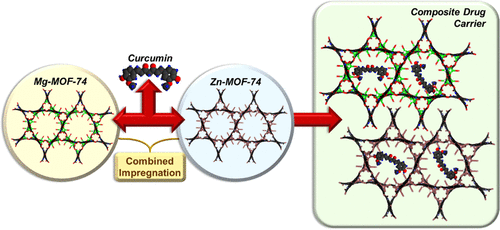当前位置:
X-MOL 学术
›
ACS Appl. Bio Mater.
›
论文详情
Our official English website, www.x-mol.net, welcomes your feedback! (Note: you will need to create a separate account there.)
Mixing Mg-MOF-74 with Zn-MOF-74: A Facile Pathway of Controlling the Pharmacokinetic Release Rate of Curcumin
ACS Applied Bio Materials ( IF 4.7 ) Pub Date : 2021-08-11 , DOI: 10.1021/acsabm.1c00585 Shane Lawson 1 , Andrew Siemers 1 , Jason Kostlenick 1 , Qasim Al-Naddaf 1 , Kyle Newport 1 , Ali A Rownaghi 1 , Fateme Rezaei 1
ACS Applied Bio Materials ( IF 4.7 ) Pub Date : 2021-08-11 , DOI: 10.1021/acsabm.1c00585 Shane Lawson 1 , Andrew Siemers 1 , Jason Kostlenick 1 , Qasim Al-Naddaf 1 , Kyle Newport 1 , Ali A Rownaghi 1 , Fateme Rezaei 1
Affiliation

|
Recently, metal–organic frameworks (MOFs) have been widely employed as potential drug-delivery platforms; however, most studies have focused on the initial aspects of material development and have made little progress toward using MOFs as a means of controlling the pharmacokinetic rate of drug delivery. Nevertheless, it was recently determined that MOFs with highly soluble metal centers impart faster pharmacokinetic properties, so it stands to reason that combining two MOFs with different metal center solubilities could be used to control the pharmacokinetic release rate. To this end, in this study we varied the ratio of Mg-MOF-74 and Zn-MOF-74 between 80:20, 60:40, 40:60, and 20:80 wt % Mg:Zn to control the pharmacokinetic release rate of 30 wt % curcumin. The drug loading was characterized by using Fourier transform infrared spectroscopy and N2 physisorption, where it was confirmed that curcumin was impregnated successfully. More importantly, the drug delivery experiments in phosphate buffered saline from 0 to 24 h at 37.4 °C revealed that increasing the Mg-MOF-74 concentration enhanced both the raw amount of curcumin delivered and the pharmacokinetic rate of drug delivery. Specifically looking at the rate of drug delivery, drug diffusion constants of 0.17, 0.23, 0.24, and 0.26 h1/2 were calculated for the 20:80, 40:60, 60:40, and 80:20 Mg–Zn-MOF-74 samples, respectively, which indicated the profound relationship between the Mg-MOF-74 loading and the rate of curcumin delivery. In this regard, this study successfully demonstrated a potential pathway of controlling the pharmacokinetic rate of drug release from MOFs which can be considered a promising advancement in pharmacological medicine.
中文翻译:

将 Mg-MOF-74 与 Zn-MOF-74 混合:控制姜黄素药代动力学释放速率的简便途径
最近,金属有机框架(MOF)已被广泛用作潜在的药物递送平台。然而,大多数研究都集中在材料开发的初始方面,并且在使用 MOF 作为控制药物递送的药代动力学速率的手段方面进展甚微。然而,最近确定具有高度可溶性金属中心的 MOF 赋予更快的药代动力学特性,因此有理由将两种具有不同金属中心溶解度的 MOF 组合用于控制药代动力学释放速率。为此,在本研究中,我们在 80:20、60:40、40:60 和 20:80 wt % Mg:Zn 之间改变 Mg-MOF-74 和 Zn-MOF-74 的比例以控制药代动力学释放姜黄素含量为 30 wt%。载药量通过傅里叶变换红外光谱和 N2物理吸附,证实姜黄素已成功浸渍。更重要的是,在 37.4 °C 下 0 到 24 小时在磷酸盐缓冲盐水中进行的药物递送实验表明,增加 Mg-MOF-74 浓度会提高姜黄素的原始递送量和药物递送的药代动力学速率。具体观察药物输送速率,药物扩散常数为 0.17、0.23、0.24 和 0.26 h 1/2分别对 20:80、40:60、60:40 和 80:20 的 Mg-Zn-MOF-74 样品进行了计算,这表明 Mg-MOF-74 负载量与姜黄素递送速率之间存在深刻的关系. 在这方面,本研究成功地证明了一种控制 MOF 药物释放的药代动力学速率的潜在途径,这可以被认为是药理医学的一个有希望的进步。
更新日期:2021-09-20
中文翻译:

将 Mg-MOF-74 与 Zn-MOF-74 混合:控制姜黄素药代动力学释放速率的简便途径
最近,金属有机框架(MOF)已被广泛用作潜在的药物递送平台。然而,大多数研究都集中在材料开发的初始方面,并且在使用 MOF 作为控制药物递送的药代动力学速率的手段方面进展甚微。然而,最近确定具有高度可溶性金属中心的 MOF 赋予更快的药代动力学特性,因此有理由将两种具有不同金属中心溶解度的 MOF 组合用于控制药代动力学释放速率。为此,在本研究中,我们在 80:20、60:40、40:60 和 20:80 wt % Mg:Zn 之间改变 Mg-MOF-74 和 Zn-MOF-74 的比例以控制药代动力学释放姜黄素含量为 30 wt%。载药量通过傅里叶变换红外光谱和 N2物理吸附,证实姜黄素已成功浸渍。更重要的是,在 37.4 °C 下 0 到 24 小时在磷酸盐缓冲盐水中进行的药物递送实验表明,增加 Mg-MOF-74 浓度会提高姜黄素的原始递送量和药物递送的药代动力学速率。具体观察药物输送速率,药物扩散常数为 0.17、0.23、0.24 和 0.26 h 1/2分别对 20:80、40:60、60:40 和 80:20 的 Mg-Zn-MOF-74 样品进行了计算,这表明 Mg-MOF-74 负载量与姜黄素递送速率之间存在深刻的关系. 在这方面,本研究成功地证明了一种控制 MOF 药物释放的药代动力学速率的潜在途径,这可以被认为是药理医学的一个有希望的进步。


























 京公网安备 11010802027423号
京公网安备 11010802027423号